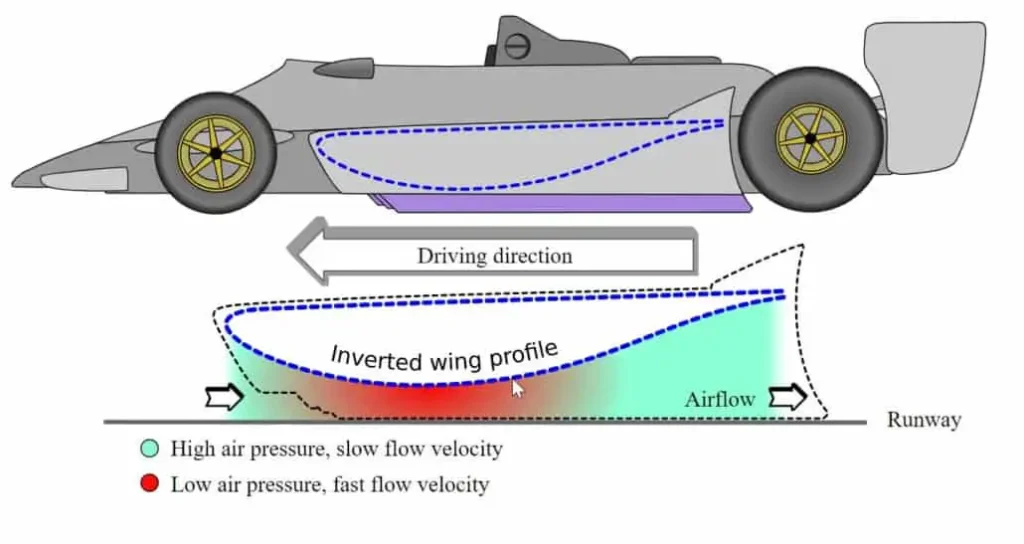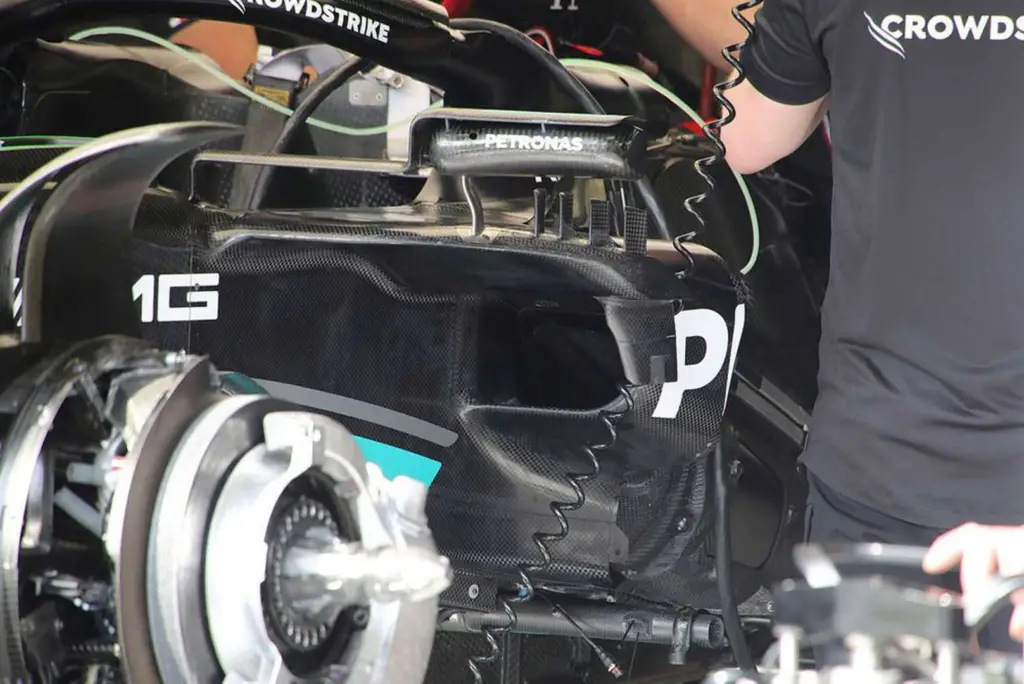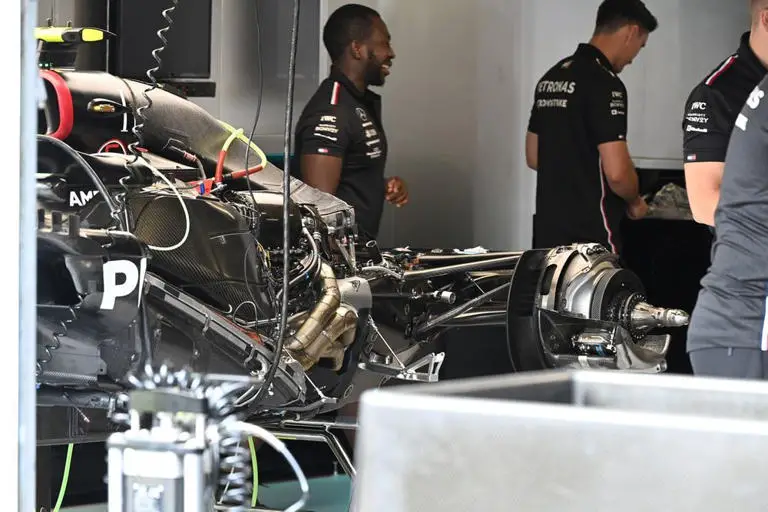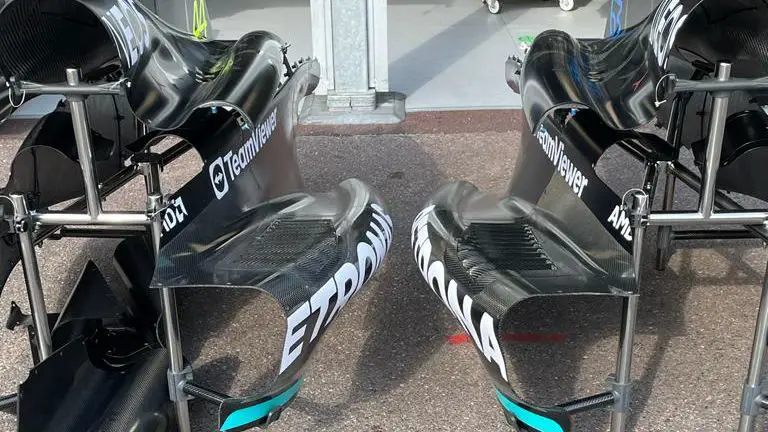Will the Mercedes Upgrades turn the tide a Monaco? The Mercedes W14 has been struggling to keep up with Red Bull in the 2023 Formula 1 season. The Silver Arrows have not won a single race so far. They are trailing Red Bull by 86 points in the constructors’ championship.
The main reason for the deficit is that the team stuck with their “zero pod” design. The first races proved the car was no match for Red Bull. The zero-pods were supposed to improve the aerodynamics, downforce and cooling of the car. It also caused a lot of problems, such as reduced top end speed, sonar interference, instability, and overheating.
However, they are hoping to turn things around with a major upgrade package. Its first outing is at the Monaco Grand Prix. After weeks of speculation, the long awaited Mercedes Upgrades are finally set to arrive.
Mercedes Upgrades – The Zero Pod Has Gone

The upgrade package is expected to be a significant departure from the design concept that Mercedes have pursued since the beginning of 2022. The most noticeable change is the removal of the zero-pods. These were distinctive sidepods that had no visible inlet or outlet.
The new sidepods are much more conventional and similar to those of Red Bull and Ferrari. They have larger inlets and outlets, which should improve the airflow and heat management of the car.
They also have a more streamlined shape, which should reduce drag and increase downforce.
Its Not Only The Zero Pod That Has Gone
The new sidepods are not the only change that Mercedes have made to their W14 car. They have also modified the front wing, the bargeboards, the floor, and the rear wing, among other parts.
The aim is to improve the speed, balance and performance of the car.
The new technical regulations were designed to reduce the aerodynamic performance of the cars and make them more raceable. They included changes such as reducing the size and complexity of the front and rear wings, banning blown axles, limiting underfloor fins, and introducing a standard brake duct design.
These changes have affected Mercedes more than Red Bull, as they have disrupted their low-rake philosophy. Low-rake cars have a smaller angle between the front and rear of the car, which creates less downforce but also less drag.
High-rake cars have a larger angle between the front and rear of the car, which creates more downforce but also more drag.
Mercedes have been using a low-rake design since 2014, when they began their dominance of Formula 1. They have lost a lot of downforce and grip, especially at the rear of the car. Red Bull, on the other hand, have been using a high-rake design for years, and have gained an advantage with the new regulations.
Mercedes Explains The Whole Concept Is Changed
Mercedes has now explained
“When we talk about aero, we’re not just talking about the shape of the car and the bodywork.
Mercedes F1 Team
It’s also about how we use the car, how we control the car, how we evolve the balance and set-up to work with the aero package. Because those factors also impact the aerodynamic performance on track.”
While some aerodynamic performance comes from the things you can see, such as the front and rear wings and the sidepods, the biggest improvements happen with how the airflow is managed underneath the car and through the diffuser.

Changes in those areas such as the venturi tunnel designs, where the car runs in relation to the ground, its rake and its ride platform – are much more important and have a greater influence than changing the shape of an engine cover or sidepod.
The Six Major Changes To The W14 Explained
Mercedes has provided an official description of the six most significant changes taht have been made to the W14,
The Mercedes W14 Front Suspension
The top wishbone forward leg inboard pick-up has been lifted. This change results in improved positioning of wishbone wake, which in turn improves onset flow into the sidepod, therefore improving cooling performance.

The Mercedes W14 Floor Fences
There has been a local load change in fence camber, which results in an increased local load and improved flow to the diffuser. This should deliver more rear downforce.

The Mercedes W14 Sidepod Inlet
A wide and high sidepod inlet helps improve flow to the floor edge, which results in more floor load and also improved flow to the rear corner.

The Mercedes W14 Sidepods And Bodywork
The increased bodywork width increases local downforce and also improves the flow to the rear wing assembly and rear corner.

The Mercedes W14 Rear Wing
The increased camber of the rear wing flap results in increased rear wing load, which in turn drops the pressure behind the car – thereby increasing rear floor load.

The Mercedes W14 Rear Brake Duct Winglets
A second cascade of cake-tin winglets added to the additional winglet array adds local winglet load. This also drops the pressure behind the lower suspension legs, increasing load on these too.

Monaco Is A Crucial Test
The Monaco Grand Prix will be a crucial test for Mercedes and their upgraded W14 car. Monaco requires high downforce, low drag, good traction, and precise handling. It is also a track where overtaking is very difficult, so qualifying is very important.
Mercedes have not won in Monaco since 2019, when Lewis Hamilton held off Max Verstappen in a tense battle.
Since then, Red Bull have won twice in Monaco, with Verstappen in 2020 and Sergio Perez in 2022. Verstappen is also leading the drivers’ championship by 23 points over Hamilton, after winning four out of five races this season.
Mercedes is hoping that their upgrades will give them a chance to fight back against Red Bull in Monaco and beyond. They are not expecting a miracle, but they are confident that they have made a step forward.

“It won’t be a silver bullet; from my experience, they do not exist in our sport. We hope that it gives the drivers a more stable and predictable platform. Then we can build on that in the weeks and months ahead.”
Toto Wolff
Read More About the Monaco Grand Prix Here
Mercedes W14 upgrades – The Questions Remain
- Will Mercedes be able to challenge Red Bull in Monaco?
- Will their upgrades work as expected?
- Will they be able to close the gap in the championship?
We will find out this weekend at the Monaco Grand Prix.
References
Goodbye zero-pods! First image of new Mercedes W14 – PlanetF1
Mercedes upgrades: What to expect from W14 changes | F1 News – Sky Sports

